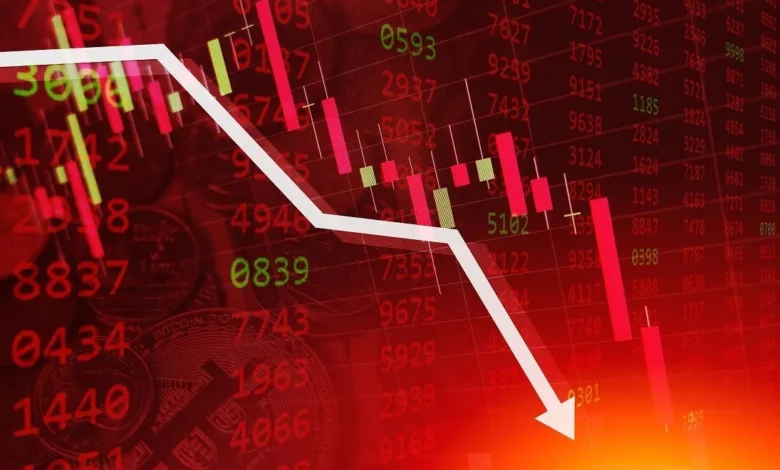Terrible Budget Or Terrible Thursday, Why Is The Stock Market Bleeding, And How Have The Stock Markets Perceived The Union Budget?
Indian stock market experienced a decline for the fifth consecutive session, influenced by global market downturns and new tax hikes on investment gains and derivatives trading announced in the Union Budget. The Sensex dropped by 650 points, while the Nifty50 fell by 195 points. Axis Bank led the losses, while SBI Life Insurance shares surged due to strong profit growth.

Budget And The Stock Markets
The equity indices in India opened lower for the fifth straight session on Thursday, affected by global market declines and the government’s recent tax increases on equity investment gains and derivatives trading. This led to selling pressure across all sectors.
By 9:23 am, the BSE Sensex was down 650 points, or 0.80%, at 79,518, and the Nifty50 had dropped 195 points, or 0.80%, to 24,218.
The Nifty50 has fallen about 2.3% from its record highs reached last week, recording losses for five consecutive sessions; three of these losses occurred after the Union Budget on Tuesday, which included tax hikes on long-term and short-term capital gains and derivatives trading.
Within the Sensex pack, Axis Bank was the biggest laggard, falling 6% after reporting a smaller-than-expected first-quarter profit due to higher provisions amid deteriorating asset quality. Tata Steel, JSW Steel, Power Grid, and ICICI Bank also opened lower.
Jindal Steel & Power saw a 5% drop after reporting a decline in first-quarter profit due to higher costs.
On the other hand, SBI Life Insurance shares jumped 3% in early trade after the firm reported a standalone net profit of Rs 520 crore for the first quarter ended June 2024, marking a 36% year-on-year growth.
On the sectoral front, the Nifty Bank fell 1%, dragged down by the broader market trends.
:max_bytes(150000):strip_icc()/us-stock-market-time-of-day-tendencies---spy-56a22dc03df78cf77272e6a2.jpg)
Terrible Budget or Terrible Thursday?
The overall market reaction to the Budget was neutral.
Investors absorbed the changes to tax rates, which were positive for the salaried class, and the adjustments to capital gains taxes (CGTs), which were negative due to the removal of indexation and increased rates.
Other proposals primarily focus on supporting rural development, taxing buybacks as dividends, altering customs duties across multiple sectors, and increasing funding for clean energy.
There is a slight moderation in the growth of capital expenditure outlays for defense, fertilizers, railways, roads, and urban infrastructure. Additionally, foreign companies will benefit from lower taxes, and the so-called angel tax for startups has been abolished.
There is a notable absence of any direct boost to consumption, which was widely anticipated after the elections. However, if the new employment-linked incentive scheme functions as intended, it could generate employment opportunities, leading to greater consumer spending.
Tax simplifications should also benefit companies in general.
Valuations for the Nifty remain stable at around 21x price-to-earnings (P/E) for one-year expected forward EPS. Midcaps and small caps are at a 60% premium to large caps.
Income tax cuts may indirectly benefit discretionary consumption and FMCG stocks.
The ongoing, albeit moderated, emphasis on infrastructure growth and affordable housing, along with rural development, should foster bullish sentiment for sectors like cement, paints, pipes, tiles, sanitaryware, cables and wires, and other building materials, as demand is expected to improve directly or indirectly in these sectors.
However, the reduction in PMGSY allocation could be a negative factor, though other rural schemes may offset its impact.
The reduction in customs duties for mobile handsets might negatively impact Dixon, but it could indirectly benefit telecom services companies if it stimulates demand for 5G handsets and consequently increases data demand. Other duty cuts on metals will aid the jewelry sector and electric vehicles (EVs).
Renewables remain a key focus area, and with the removal of the angel tax, this could be a favorable year for renewables and internet-based businesses that attract private equity (PE) and venture capital (VC) support.

From a technical perspective, the market is poised for continuity.
The bull run is expected to persist, though there is no macroeconomic impetus driving it. The Vix declined over the last two sessions, typically a bullish indicator. Midcaps and small caps outperformed the Nifty, which is unsurprising.
Among sector movements, the Nifty Media index emerged as the top performer, possibly due to expectations that higher discretionary income will lead to increased spending on entertainment.
The FMCG and consumer durables sectors also experienced gains. Although FMCG has underperformed over the past year with a positive return of around 18%, this Budget could accelerate its uptrend.
The consumer durables sector, with a strong performance of 40% return over the last year, could also see further growth if disposable incomes rise.
While there are no specific measures affecting the pharma or healthcare sectors, both have outperformed the benchmark.
The Information Technology sector, seemingly unaffected by the Budget, has seen its index rise by 13% in the past month and gained slightly post-Budget.
The Nifty Oil & Gas Index appears unstable, as downstream oil marketing companies (OMCs) anticipated compensation for gas price cuts, which has not been provided.
The Auto Index has also seen a slight decline.
Sectors reliant on infrastructure, such as Industrial Metals, along with the broader Nifty Infra index, have dropped, likely due to disappointment over the slowed growth in infrastructure allocation.
The Realty Index has also decreased, possibly for similar reasons.
The financial sector experienced the most significant share price and index declines. The Bank Nifty fell, with the Nifty Private Banks index dropping even further.
The Bank Nifty is heavily weighted toward large private banks, but public sector banks, as well as the Financial Services and NBFC sectors, also saw a selloff.
Given the high sector weightage of banks and financials in the Nifty, this could negatively impact overall market trends if it continues.

Experts’ View
“Global cues have turned distinctly negative with a sharp 3.64% decline in the Nasdaq, marking the worst cut in 2024.
The tech stocks, which have been driving the rally in the US, are facing significant selling pressure due to worse-than-expected results and news.
In India, too, sentiments have turned somewhat negative due to the Budget proposals to raise the capital gains tax,” said V K Vijayakumar, Chief Investment Strategist at Geojit Financial Services.
Deepak Jasani, Head of Retail Research at HDFC Securities, commented, “Nifty could stay in the 24,141-24,595 range in the near term.”
Global Markets
Asian shares suffered on Thursday as a slump in global tech stocks drove investors to seek safer assets, such as short-dated bonds, the yen, and the Swiss franc.
MSCI’s broadest index of Asia-Pacific shares outside Japan fell by 0.7%, Japan’s Nikkei plunged by 2.9%, and South Korea’s KOSPI dropped by 2%. Hong Kong’s Hang Seng decreased by 0.6%, despite Beijing’s latest easing measures offering little support.
On Wall Street, the Nasdaq dropped nearly 4%, marking its worst one-day fall since 2022. Disappointing earnings from Alphabet and Tesla shook investor confidence in the highly valued Magnificent Seven stocks.
FIIs Net Sellers
Foreign investors remained net sellers for the second consecutive session, selling shares worth about $1 billion over the two sessions following the Union Budget.
Oil Prices Decline
Oil prices declined on Thursday due to concerns over weak demand in China, the world’s largest crude importer, and expectations of a nearing ceasefire deal in the Middle East.
This offset gains from the previous session following draws in U.S. inventories. Brent crude futures for September fell by 38 cents, or 0.5%, to $81.33 a barrel, while U.S. West Texas Intermediate crude for September slid by 33 cents, or 0.4%, to $77.26 per barrel.
Currency Watch
The Indian rupee dropped by 1 paisa to an all-time low of 83.72 against the US dollar in early trade.
The dollar index, which tracks the movement of the greenback against a basket of six major world currencies, declined by 0.17% to 104.21.
The Last Bit, the market remains in a tight trading range in the short term, with the long-term trend still bullish.
A breakout of 3% plus or minus – approximately 750 points on the Nifty – would reset the medium-term trend, but this Budget does not seem to have provided the necessary triggers in either direction.



